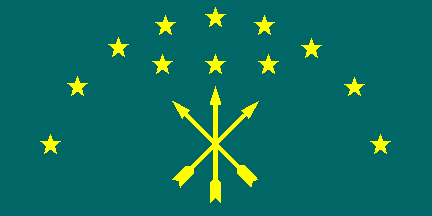 image by Nikolay Khimenkov, 05 Jul 1999
image by Nikolay Khimenkov, 05 Jul 1999
FOTW beschäftigt sich mit der Wissenschaft der Vexillologie (Flaggenkunde).
Alle auf dieser Website dargebotenen Abbildungen dienen ausschließlich der Informationsvermittlung im Sinne der Flaggenkunde.
Wir distanziert uns ausdrücklich von allen hierauf dargestellten Symbolen verfassungsfeindlicher Organisationen.
Last modified: 2021-07-24 by valentin poposki
Keywords: adygeya | urquhart (david) | star: 5 points (yellow) | stars: 12 (yellow) | stars: 7 | arrows: 3 | tribe | peace | islam | life | freedom | sausryko | aquamarine | nart | circassian | stars: arch |
Links: FOTW homepage |
search |
disclaimer and copyright |
write us |
mirrors
 image by Nikolay Khimenkov, 05 Jul 1999
image by Nikolay Khimenkov, 05 Jul 1999
(Note: You need an Unicode-aware software and font to correctely view the cyrillic text on this page. See here transliteration details).
Adyge is the name this people call itself. They are
usually called Circassian. In fact
Adygea is only a part of the land where Cirkassians live [the
others being [Karachay-]Cherkessia
and Kabard-Balkaria]. From 1922 to 1991
Adygea was only a autonomus district, now
it is a Republic.
Giuseppe Bottasini, 1995
Adygeyi are a Cherkess people, established in the northern Caucasus
along the river Kuban, near Krasnodar. The Crimean
Tatars Islamized the Adygeyi in the XVIth century by converting their
feudal lords. The Adigeyi kept good relations with Russia:
Ivan IV the Terrible’s second wife was a
Cherkess princess.
In 1829, the Ottoman Turks had to withdraw
from northern Caucasus following the treaty of Andrinople. Russia
progressively invaded the area. The Adygeyi (among others) organized the
resistance by way of religious independentist movements.
The area was incorporated into the Russian Empire in 1864.
Ivan Sache, 18 Jun 2003, quoting from
[lux01]
Adygeya is a curious case of geography, even
in the diversifed patchwork of the
Russian Federation:
It is a coastless enclave inside
Krasnodar territory,
with a multi-pedunculated shape — it is however
made of only one contiguous area, without any
enclave in or exclave of Krasnodar — although
including some bits isolated by the river Kuban
(at least according to the 1:200000 atlas
Krasnodarskiĭ kraĭ / Respublika Adygeâ —
Topografiĉeskaâ Karta, 1994, jointly
published by both local governments).
António Martins, 16 Sep 1999
The flag is not new, because it was firstly drawn by David
Urquhart, a Scottish scholar sent by British Government to
substain Circassian people against Russia.
He created a flag, that is very similar to the current flag adopted
on 23 March 1992. The 12 golden stars stand for the nine
“aristocratic” tribes and the three “democratic”
tribes, while the three arrows represents peace. The background is
green and represents both Islam and life (or freedom).
Giuseppe Bottasini
12 gold stars correspond to 12 main tribes of the Adyghe nation.
Three crossed arrows symbolize union of 12 Adyghe tribes.
Nikolay Khimenkov, 20 Mar 1999
The colour of the flag is in fact
Aquamarine Green, a dark bluish green,
so says the flag law.
The colour given in art. 2 of the
law is green. But not only the
illustration to the law, but also the
description of the details of the flag
give deep aquamarine.
The supplement to the law prescribes
the size of each flag element and the
colour shade. (Published
in Sovetskaja Adigeja 63
of March 31st, 1992)
Ralf Stelter, 04 Mar 1999 and 27 Jun 1999
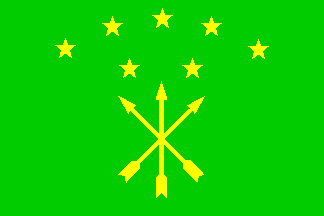 image by Nikolay Khimenkov and Ivan Sache, 18 Jun 2003
image by Nikolay Khimenkov and Ivan Sache, 18 Jun 2003
In the 1830s, a Briton called Urquhart designed
green flag with 7 stars above three crossed arrows
on a green background. This flag was used by the
Circassians in the fight
against Russian occupation.
Stuart Notholt, 17 Sep 1995
The first Adygeyi flag was created in 1834. It was green with three yellow
arrows and seven stars. Green symbolized Islam, the
arrows the union of Georgia, Armenia
and Azerbaijan, and the stars the seven allied peoples
from Caucasus.
Ivan Sache, 18 Jun 2003, quoting from
[lux01]
Lux-Wurm’s image in [lux01] differs
from the current Adygeya flag by its proportions of 2:3
and the number and arrangement of the stars, an arch of five and two more
stars placed among the arrows.
Ivan Sache, 18 Jun 2003
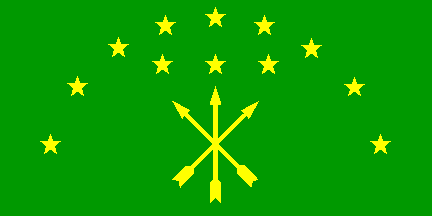 image by Nikolay Khimenkov, 05 Jul 1999
image by Nikolay Khimenkov, 05 Jul 1999
Both the flags of Cherkess
and Adygei are clearly evolved from this flag,
a version of which (with 12 stars) being also
used by the pro-German North Caucasian League
set up during World War II.
Stuart Notholt, 17 Sep 1995
quoted by Nikolay Khimenkov, 20 Mar 1999Constitution of the Republic of Adygei
Clause 59. The National flag of the Republic of Adygei is a rectangular green panel, with the pictures of twelve gold stars and three gold crossed arrows with the tips directed upwards. The ratio of the flag length and its width is 2:1.Law of the Republic of Adygei
Clause 2. The National flag of the Republic of Adygei is a rectangular green panel, with the pictures of twelve gold stars and three gold crossed arrows with the tips directed upwards. The length of the flag is 180 cm, the width is 90 cm.
On the National flag of the Republic of Adygei
March 24, 1992
The problem is to choose: either we respect word
for word the text (only it matters), and the flag
is green, or we respect the
picture in the law and the flag is dark aquamarine
(source: [cdd], 17th
June 1992).
Pascal Vagnat, 31 Mar 1999
The colour given in art. 2 of the
law is green. But not only the
illustration to the law, but also the
description of the details of the flag
(published in Sovetskaja Adigeja
No. 63, of March 31st, 1992)
give deep aquamarine. For Adygeja
the supplement to the law prescribes
the size of each flag element and the
colourshade!
Ralf Stelter, 27 Jun 1999
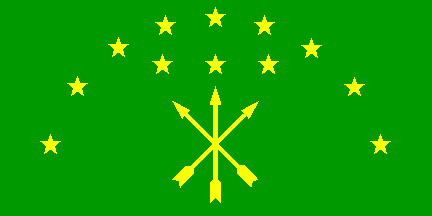 image by Nikolay Khimenkov, 20 Mar 1999
image by Nikolay Khimenkov, 20 Mar 1999
A friend of mine, just returning from a
foot trip across Adygeya (from Krasnodar
thru Maykop up to the southern border),
reported to me that all Adygeyan flags
in sight were medium green, not (dark)
aquamarine.
António Martins, 10 Sep 1999
In fact
some flags are manufactured in a
normal shade of green, and I know an
institution in Germany who received an
original flag in green, with a letter
added: note that the green shade is
wrong, it should be darker.
Ralf Stelter, 04 Mar 1999
This flag is listed under number 103 at the chart Flags
of Aspirant Peoples [eba94] as: Adyge Republic (Adygei)
- North Caucasus, Russia, based on written description.
Ivan Sache, 15 Sep 1999
 image by Nikolay Khimenkov, 20 Mar 1999
image by Nikolay Khimenkov, 20 Mar 1999
I know a variant with 3 stars are located
on an arch.
Nikolay Khimenkov, 20 Mar 1999
The arrangement of the flag’s
elements is prescribed in the same
supplementary to the law
as the colour shade. There is only one
correct arrangement possible!
Ralf Stelter, 27 Jun 1999
ad2.gif) Valentin Poposki, 25 Nov 2005
Valentin Poposki, 25 Nov 2005In the coat of arms of the Russian republic of Adygei (adopted 24
March 1992) is shown Sausryko with a torch in his right hand and riding
a fire-horse. His story is told in the national epic Nart of
Adygei.
Jos Poels, 29 Nov 1995
Official description is in the
official website, but it
is in Russian. The coat of arms is adopted March 24th 1992. Author is
D. M. Meretukov. There is not a word about the colours of the arms in the
document, so probably that is a reason why there are different
interpretations.
Valentin Poposki, 25 Nov 2005
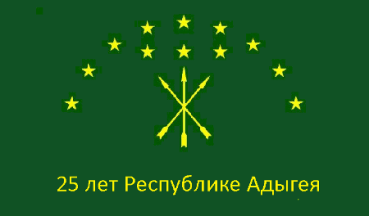 image by Valentin Poposki, 7 June 2020
image by Valentin Poposki, 7 June 2020
In 2017 the Republic of Adygeya celebrated its 25th Anniversary as an
official Republic. For the occasion flags with additional text "25 лет
Республике Адыгея" in golden lettering were made and used.
Valentin Poposki,
7 June 2020
Hosted by: Fanshop-Online.de und Handy-Shop.de
Tipp: Apple iPhone 12 im Shop